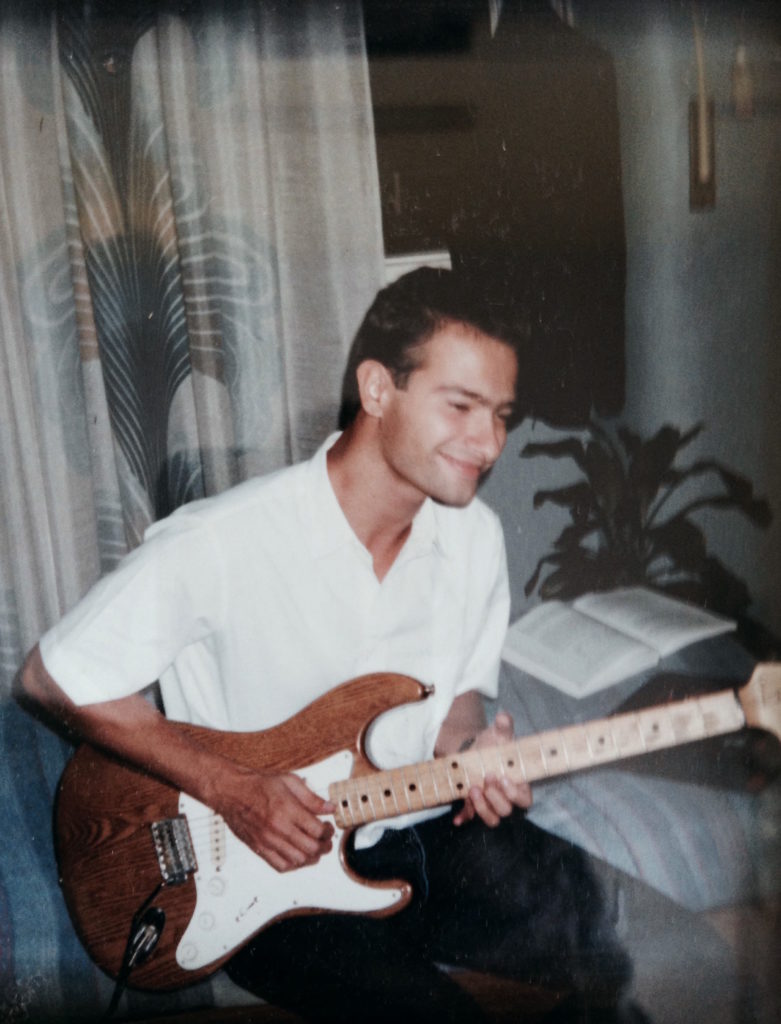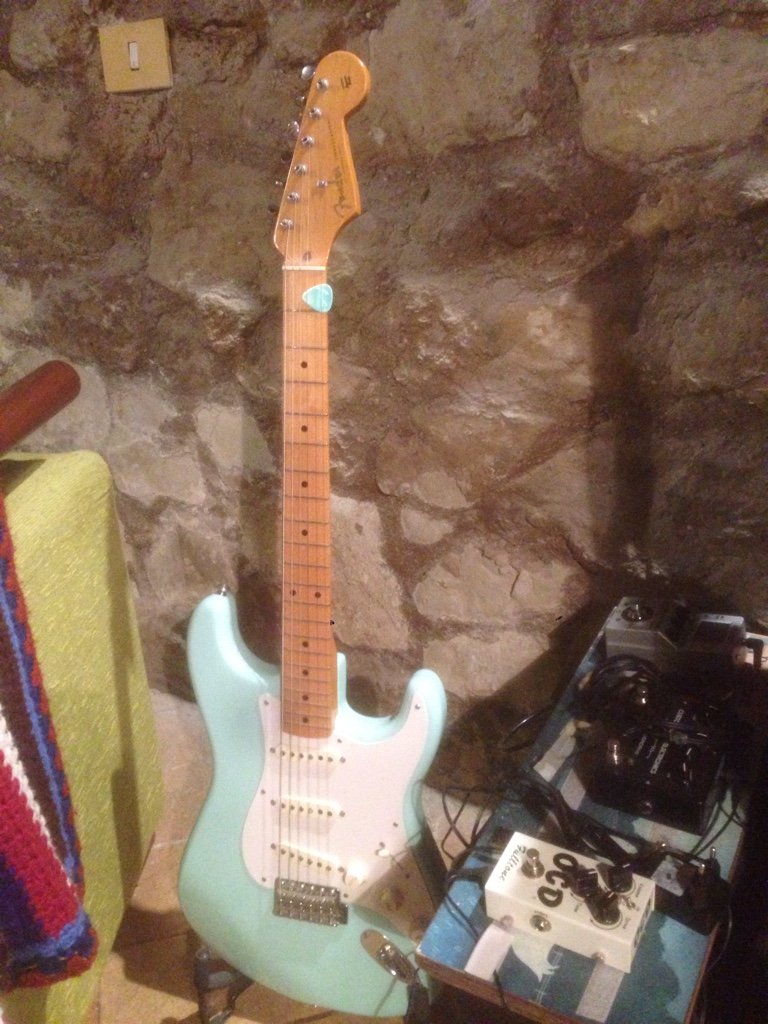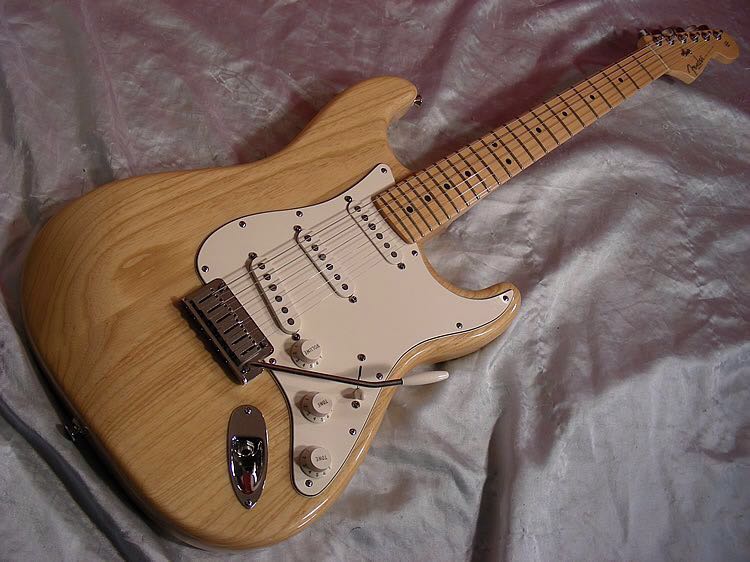Why Fender Stratocaster? Here’s the story…
As a young man, before I had an electric guitar, I read that my then-reference guitarist used a Fender Stratocaster in addition to other guitars like the Gibson Les Paul. But the Stratocaster was first on the list and it struck me. Friends told me it was an outstanding guitar. I saw one in a musical instrument store, the same one where my parents bought me my first hi-fi, but it was way too expensive. I was in high school at the time and would often deviate from the main route home to pass by that window and admire that beautiful, unreachable Stratocaster, shotgun grey and black faceplate. I dreamed of having an electric guitar someday, but I knew the Stratocaster would be unattainable.
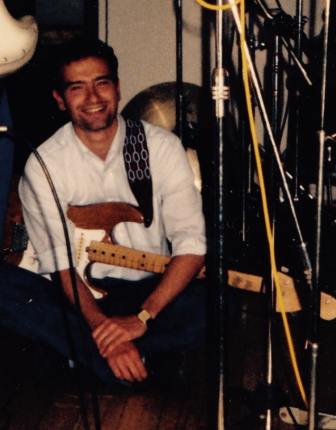
Happy with my beloved unbranded Stratocaster in my arms during a break in the rehearsal room in Rome, late 80’s.
In the summer of 1980 my parents decided it was time to get me an electric guitar. The general idea I had of an electric guitar, perhaps because I had seen it at a friend’s, perhaps because the Beatles used guitars like that, was a hollow body in dark reddish wood, with “f” openings and the pickguard under the pickups, raised from the body, and the classic headstock with 3 tuners on each side. In short, a “classic” electric guitar – I wish I had it! But I wasn’t as passionate about it as I was about the Strat. Before leaving for a vacation at the beach we passed by the store where I used to stop and admire – and dream – about the Fender. I was convinced that I was finally going to get an electric guitar the way I imagined it. It was me, my sister, who would get an electric bass, and my parents accompanied by a colleague of my father’s who knew the owner well and had offered to put in a good word for a discount.
To the shopkeeper’s classic question, “what can I get you?” my father’s answer was, “an electric guitar for this boy”. The shopkeeper turned around, reached into a cardboard box on a shelf, pulled it down, opened it, picked up an electric guitar and handed it to me. I was stunned! It was a Stratocaster, it didn’t have a logo on the headstock, there was nothing, just a “Di Marzio Powered” sticker on the pickguard, which made me believe for years that it was a DI Marzio guitar, the famous American manufacturer of pickups, instead. My first question was, “…but how much does it cost?” Having gotten the answer I feared (a third of the Stratocaster in the display case but still too much), my father told me with a smile, “…then look at it some more…” which was meant to imply that I couldn’t do anything else with it, no can do. After that the group gathered in the owner’s office to bargain with the help of my father’s colleague, a fierce negotiator. My sister and I sat waiting in the middle of the store, looking at various musical electronics, from keyboards, guitars and microphones to stereo Hifi components. After a few minutes a female employee came out of the office in tears. A few more minutes and my smiling mother came out; she walked towards me and once she was closer she said with delight: “it’s yours…”. I skipped one, maybe two heartbeats and stopped breathing. A moment that has been indelibly stamped in my mind. I couldn’t believe it! For a little more than the starting price of the guitar, we would also take home a bass guitar and an amp, as well as a couple of cables and shoulder straps. I never knew what happened in that office but I never really cared. All I could think about was that I was going to have a beautiful Stratocaster, no matter if it wasn’t “real”, not “branded”! It was identical to the 70’s Stratocaster, with the large headstock, the heavy natural ash body and maple neck. Obviously the pickups were Di Marzio, which I discovered a short time ago to be the SDS-1 with poles adjustable with a hex key, still on sale today although not very common. It was probably the happiest moment of my youth. The best and most important gift my parents ever gave me. I was the happiest teenager in the world….
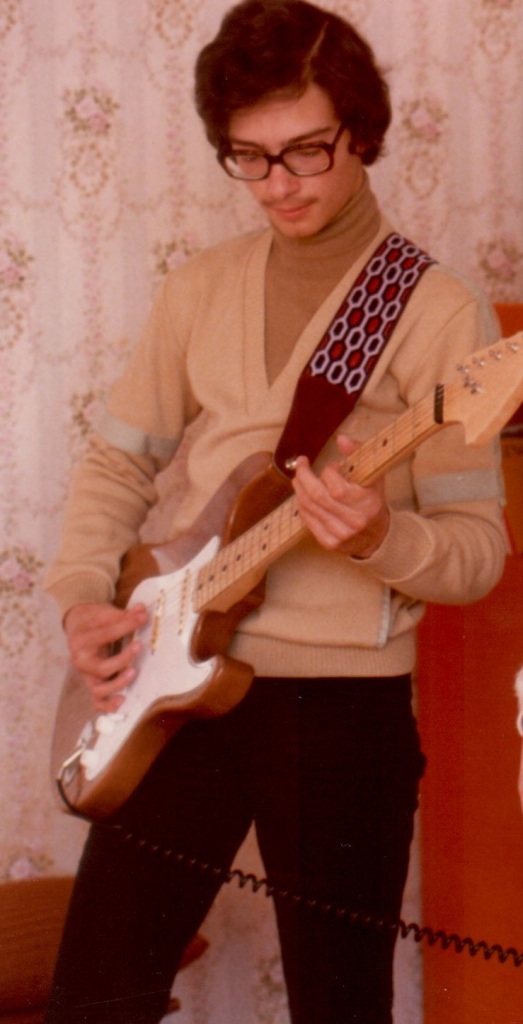
But what was I thinking by dressing up in that way (not mentioning the awkward hairstyle) in the early 80’s? What were my parents thinking? I make the gorgeous imitation Stratocaster look out of place in one of her early photos…. 😉
Too bad we came home to deposit our instruments and leave for the beach. We were bored to death at the beach, alone with our parents all day and strolling with them in the evening. We had no friends there, we didn’t know anyone. We were missing our backyard gang. That year three sisters from that backyard were at the beach in the same place. One night we met them in an arcade. At night I dreamed of walking with the oldest of them to get ice cream downtown. I woke up with a new, very strange feeling in my chest. It was my first crush. So it was a pivotal summer for me. The first electric guitar, the first, very shy “falling” if you can call it that (among other things, nothing happened). A moment of passage, of important change in life at a critical age: I would have turned 16 a little later that same summer: we would perform in front of our guests at the birthday party, for the first time with electric guitars…
36 years later, history (almost) repeats itself…
One fall afternoon on November 14, 2016, I drove both my parents and my son into town: I was going to buy my first (real) Fender Stratocaster. I wanted them to be there. They who gifted me a Strat imitation in the summer of 1980, making me the happiest teenager on Earth.
After 36 years I was realizing my then unattainable dream of having a real Stratocaster and it seemed appropriate for my parents to be there, together with my son, at the moment of closing the circle. That was also a crucial moment in my life: at the beginning of that year I had lost my job, the company I was working for as a geologist, the job I had longed for and done so much to get, was lost. Above all, I was just over 50 years old and with a small child. A rather critical situation. During the crisis period I had started playing in a band again and it helped me to maintain a certain serenity. At the time I couldn’t imagine that it would also lead me to my new job. So it was a crucial period in my life again and I wanted to go out and buy a Stratocaster again with my parents.
The 1980 one was a Made in Italy Strat, a copy of the Stratocaster produced by Fender in the 70’s, at the height of the CBS period. In the mid 60’s the founder Leo Fender, had to sell to CBS and according to many people the quality of their guitars dropped significantly. The Stratocaster of the 70’s do not enjoy great fame. Now that more than 50 years have passed the hunger for vintage keeps the price relatively high. Nothing comparable to the prices of the models of the 50’s and early 60’s, though!
When I “grew up” and had the opportunity to buy a Stratocaster, I was eventually persuaded to opt for a Paul Reed Smith Strat instead, a 1991 EG4, which was really good quality. I played with it for 23 years, but mostly at home playing along records. The desire to finally have a real Stratocaster has revived since I started playing with a band again. I have always wondered what Stratocaster I would choose if given the chance. The options are varied but many are also high priced.
My dream: well, a ’56 Stratocaster, first series, the one with the maple neck and alder body in 3 color “sunburst” shade or one of the “solid” colors they used to get from the auto industry. A classic, but unattainable: you can find them between 10 and 20 thousand euros! In that case better to get an American Vintage that replicates it as it was: you can get away with almost 2000 euros or less on the used one.
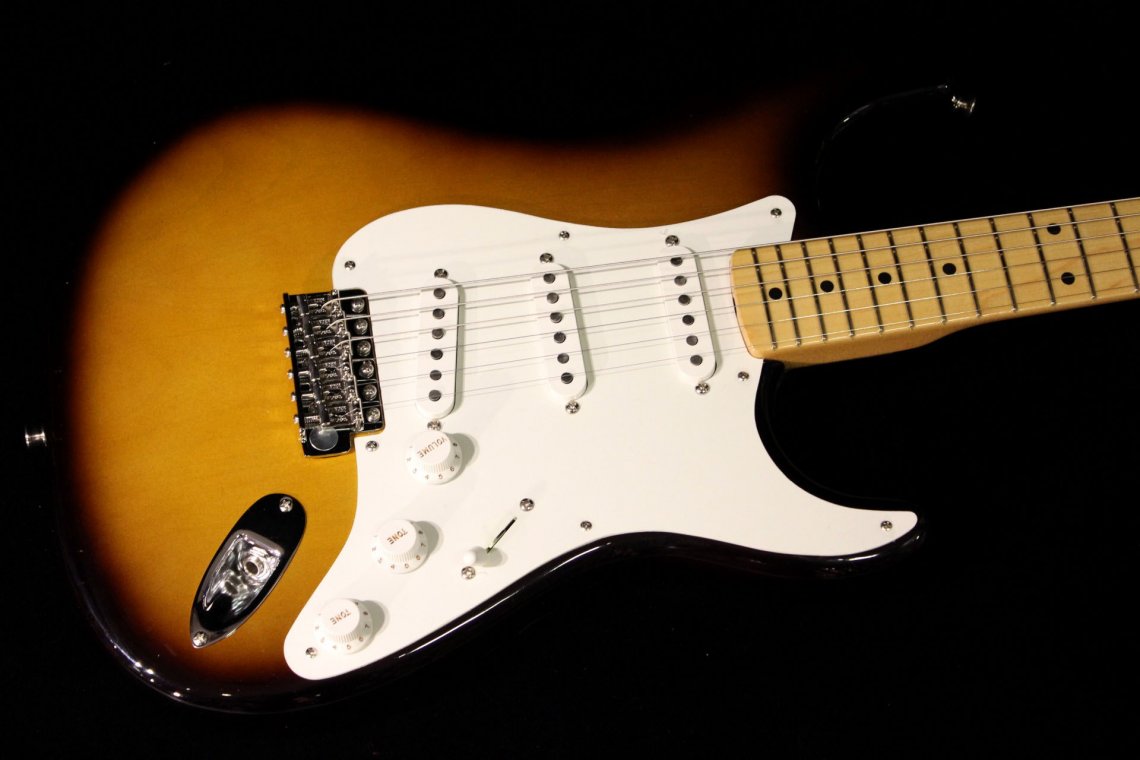
Among the modern series the most affordable made in USA are the American Standard, around 1000 euros. The interesting thing is that in the second hand you can find models of the early 2000s that used an ash body in natural finish very similar to the imitation I had.
The American Vintage series also offers replicas of the 70s, so I might find just the one my first guitar was inspired by, with heavy natural ash body, maple neck screwed to the body with 3 bolts instead of 4 and larger headstock with flashy black decals. A cheaper version is made in Mexico and is the Classic Series 70s.
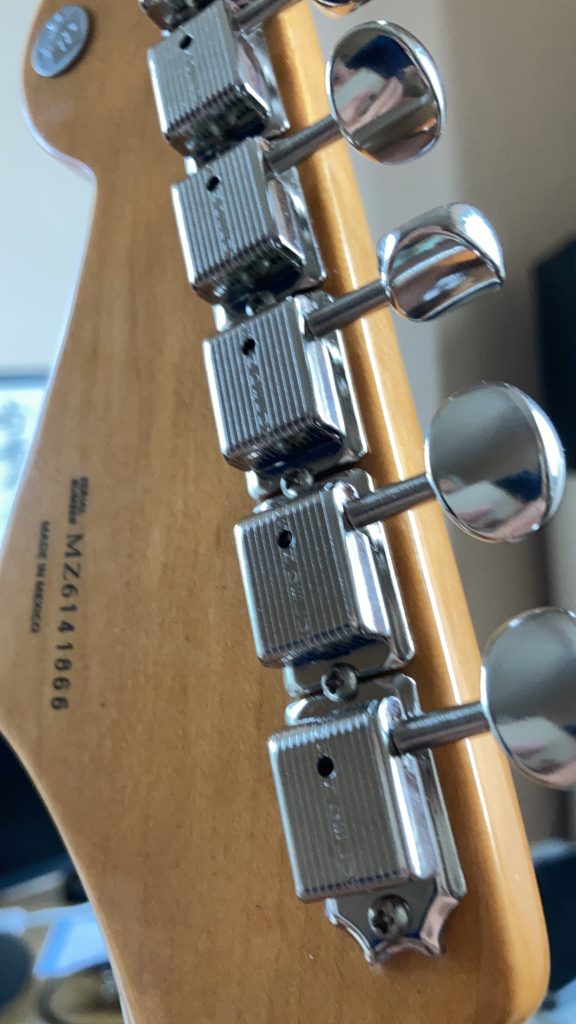
My Stratocaster was made in 2006 in Mexico to 50’s specs and this particular model is commemorative of 56, at the time 60 years of Fender. To make it even closer to the specs, in 2021 I fitted Kluson M6V0C Single-Line Deluxe tuners, with the lettering engraved as in the 50s.
Instead, when I sold the PRS in late 2016 I stumbled upon a Stratocaster made to 1950s specs in Mexico in 2006 (60th anniversary of the original model). The color is Surf Green, a sort of aquamarine green that was used on 50’s Chevrolets. Nothing like my old Strat replica. The soft V profile neck that tapers to a C profile toward the body flows beautifully, playing it is such a pleasure that it’s hard to stop. Moreover, today that color gives me a certain sense, that suggestion of the 50s and 60s when even cars and appliances, furniture, with the typical design of that era were colored in a similar way. Surely it was a lower economic effort than a new American Standard or American Vintage, but the quality can be comparable as far as the woods are concerned. Later I could swap tuners, bridge, the electronics, whatever. But not necessarily…
We must always consider that industrial production creates guitars that must be sold to make a profit. It is difficult that after an acceptable assembly the neck will be perfectly adjusted, the frets perfectly leveled, the action in place and the intonation as well. These are all things that take time and the work of the craftsmen must be paid for. But it is entirely possible to get all this right even on an industrially produced guitar. I have to say, however, that mine is already set up very well, having bought it from a luthier’s shop in Rome.
Assembling one would also have been an option. There are small companies that make replacement parts for famous guitars. They can afford to take care of the parts without losing earnings. The quality is usually very high at a much lower cost than the corresponding branded models. Ron Kirn, an experienced American builder, points out that 99% of any guitar that comes out of the factory will need at least fret filing to sound as good as it is worth. He then adds that we’d all be amazed if we knew how many famous guitarists use the above replacement parts on their Fender and Gibson instruments, which they are paid to play. Nowadays, that wood cutting is totally computerized, it is enough to have the original license to get the same, identical bodies and necks from Fender, Gibson or whoever. Manufacturers such as Warmoth, USA Custom Guitars and Allparts, for example, have the Fender license, so they build spare parts perfectly in line with the originals, with “custom shop” quality (also in the sense that everything is customizable) at a quarter of the price of the branded ones. In short, if the same operator was hired by Fender, he would be cutting the same components by giving orders to a computer, in exactly the same way. And the same component would cost at least twice as much. However, today I decided to buy a production one from the used market.
At first I was thinking of using a body and neck from the same manufacturer (Warmoth, Allparts, etc.) and then look for as many original Fender parts as possible, “vintage” (Fender/Gotoh) tuners and bridge, 50’s 8-screw faceplate, Pure Vintage or Custom Shop pickups, the works… but eventually I would have spent more.
I did not make a rational choice, as often happens to me. If anything, it was a choice of the heart: I’m very fond of the image of Leo Fender, a gentle and good man, humble, with great skills in various fields, who, even if he didn’t play, managed to revolutionize the music world with a product that has remained essentially unchanged for almost 70 years. I liked the idea of having a Stratocaster that replicated the original model of the time, with the so-called vintage specifications. Everyone, quite rightly, advised me to try many before choosing. That’s the way it’s done. But I’m not a great guitarist, I can manage, of course, but maybe that’s why I don’t tend to think that the right guitar would make my job easier; if anything, I think that if something doesn’t work, it means that I have to improve my technique.
On the first try I found this excellent made in Mexico Stratocaster, in the color I preferred; I immediately bonded with it. I even find the vintage neck comfortable, the build quality doesn’t seem low at all. The sound is superior to all expectations.
Its Fender Vintage Alnico V pickups do a great job and many who have changed them have then gone back to the originals. I’ll keep them for a while I think; someday I might swap them with Pure Vintage pickups or Custom Shops, better quality pickups even closer to the original 50s specs; they seem to faithfully reproduce the Fender originals of the era and they don’t even cost nonsense.
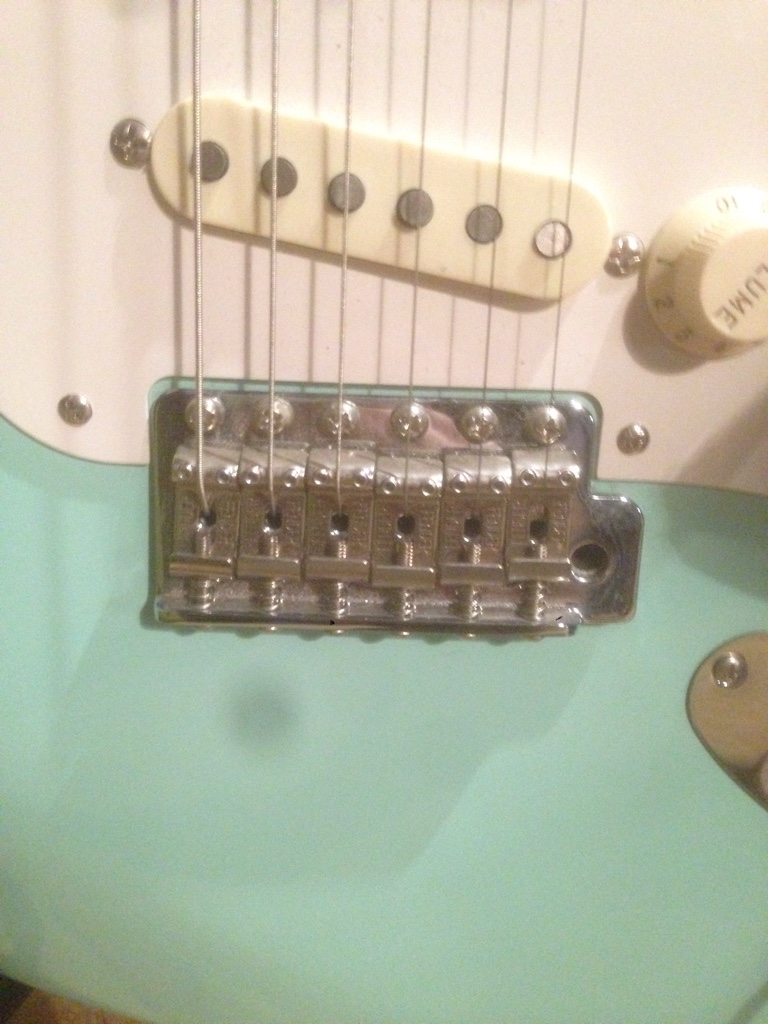
The saddles on the bridge are vintage style and have Fender lettering engraved on them. After trying out several, I replaced them with Fender Pure Vintage with “Fender Patent” lettering like the originals of the era.
The neck is maple with a vintage profile, that is, with a 7.25 inch radius of curvature. It doesn’t bother me in the least: some say that it is not comfortable for the modern style, with all those bendings, which was not very common in the 50s and 60s. That’s why such “convex” keyboards were in fashion, to facilitate barre chords. Instead, I was amazed by the playability of this neck! A comfort that I can’t get out of my head, sensations that have totally belied those that reluctantly led me to opt for the PRS after having tried a Stratocaster. A whole different thing compared to my former PRS this time. I couldn’t certainly complain about the PRS, but it seems like the neck was more Gibson-style with jumbo frets. My new Strat has vintage narrow frets, but it’s a pleasure for me to play it. Am I a great guitarist, comfortable with any guitar? Come on! No, it’s just that a good setup is everything!
It is said that Made in Mexico necks and bodies are actually produced by Fender in Corona, California, then shipped to Mexico for assembly. A Mexican Classic Series (more vintage) or Classic Player (less vintage but a bit more cared for) can therefore boast specs very close to that made in the USA. The mechanical and electrical parts can be upgraded with high quality parts as much as you want and you would have an original Fender of all respect without spending exorbitant amounts of money. But there’s no guarantee that my Kluson-style Ping tuners and vintage aluminum Fender tremolo would really need to be replaced. We’ll see. I just had to replace the saddles for a defect, first with very good Callaham saddles (taking the opportunity to put in their 6 steel screws as well), and then switch to Fender Pure Vintage saddles that fit it better both in size and “vintage look”.
For now I am enjoying the fulfillment of my boyhood dream: I’m finally playing with a Fender Stratocaster and it’s a pleasure! I should give it a name. My son’s name is Leo(nardo), after Leo(nidas) Fender, who was born on August 10 like me. Perhaps I should call her Lea…
